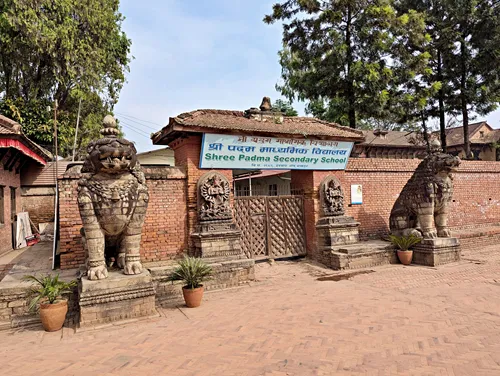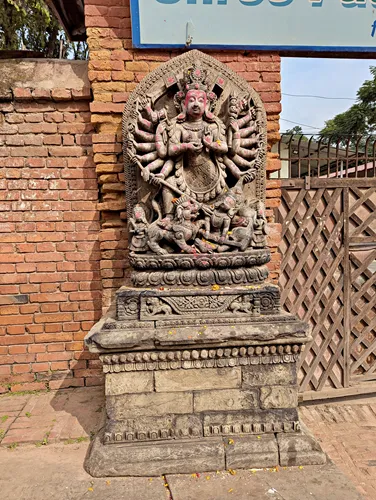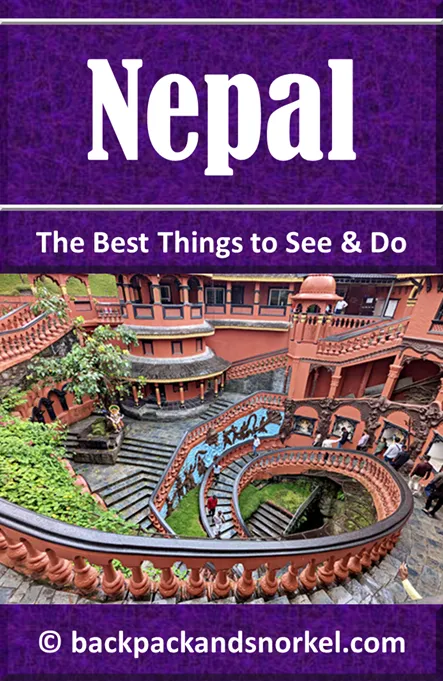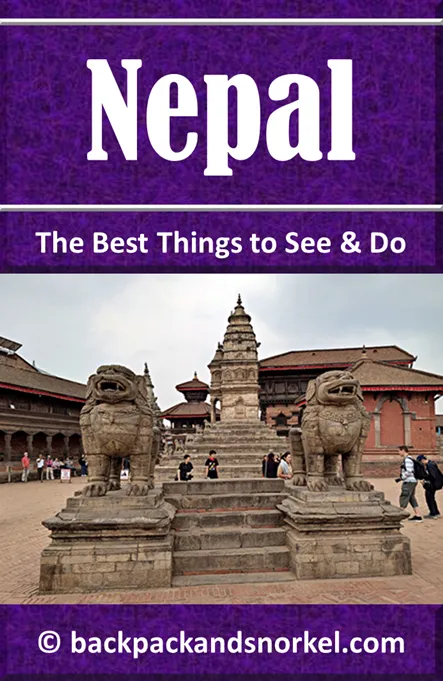Ugrachandi & Bharib Statues: Your Guide to Bhaktapur's Fierce Deities - Nepal Purple Travel Guide
(map, reviews)
This is Premium Content! To access it, please download our
Backpack and Snorkel Purple Travel GuideLocated near the main entrance to the palace complex in front of the gate to a secondary school, these stone sculptures are not only remarkable late 17th century works of art, but also part of an interesting legend about their creator and King Bhupatindra Malla.



Here at Backpack and Snorkel Travel Guides, we typically promote self-guided walking tours.
But we realize that not everybody likes to walk by themselves in a foreign city. So, just in case that you rather go with ab guide: NO PROBLEM! Please see the Viator tours below.
free GuruWalk tours
paid Viator tours
The Origin of the Names of the Ugrachandi & Bharib Statues
The name Ugrachandi combines ‘Ugra’ (meaning fierce or terrifying) and ‘Chandi’ (a form of the goddess Durga). Durga represents a fierce manifestation of Shakti, the divine feminine power, often invoked to destroy evil and protect the faithful.
Bhairab, also spelled Bhairava, is a wrathful form of Lord Shiva, known for his fiery temperament and role as a destroyer of demons. Together, Ugrachandi and Bhairab symbolize the divine balance of masculine and feminine power, wrath, and protection.
History and Craftsmanship
The statues were commissioned in 1707 by King Bhupatindra Malla, a renowned patron of the arts and architecture in Bhaktapur. Both figures are carved from a single block of stone and are celebrated for their incredible detail and dynamic posture.
Ugrachandi (on the left) is depicted with eighteen arms, each holding a different weapon. She stands atop a demon, symbolizing her triumph over evil.
Bhairab (on the right) is shown with a fearsome expression, holding weapons and stepping on a subdued figure, embodying his role as a destroyer of chaos.
The statues were placed at the palace entrance to guard the royal precinct, reflecting ancient Hindu beliefs in divine guardianship. Unfortunately, this part of the palace was obliterated by the 1934 earthquake, and what was left was later converted into a secondary school.
There is also an interesting legend about the creation of the Ugrachandi & Bharib Statues – we call it:
The Legend of the Ugrachandi & Bharib Statues, and a King’s Obsession with Perfection
The story begins in 1707, during the reign of King Bhupatindra Malla, one of Bhaktapur’s most visionary rulers and a passionate patron of the arts. The king commissioned a master sculptor to create a statue of Ugrachandi, a fearsome manifestation of the goddess Durga. The result was so breathtaking - eighteen arms, each wielding a weapon, standing atop a vanquished demon - that the king feared no other kingdom should possess such a divine masterpiece. (Background: at that time, there was a fierce artistic rivalry between the Malla kings of the three kingdoms: Kathmandu (Kantipur), Patan (Lalitpur) and Bhaktapur (Bhadgaon)).
In a dramatic twist worthy of folklore, the king is said to have ordered the sculptor’s right hand to be cut off, ensuring the statue could never be replicated elsewhere. Yet the artist, undeterred and driven by devotion or perhaps defiance, went on to create the equally fearsome statue of Bhairab, a wrathful form of Shiva who now stands beside Ugrachandi. Upon completing this second marvel, the legend claims the king ordered the sculptor’s other hand to be removed, sealing his fate but preserving the exclusivity of his creations.br>While there is no written historical record to confirm the tale, this oral legend is deeply woven into the cultural fabric of Bhaktapur. It speaks not only to the remarkable skill of Newar artisans but also to the intense rivalry among the Malla kings, who competed to adorn their cities with the most magnificent temples, palaces, and sculptures.br>Interestingly, many ancient statues in Nepal do not bear the names of their creators - a tradition that may reflect the era’s royal pride, where kings took credit for the artistic glory of their kingdoms.
Back to your self-guided tour
Author: Rudy at Backpack and Snorkel
Bio: Owner of Backpack and Snorkel Travel Guides. We create in-depth guides to help you plan unforgettable vacations around the world.
Other popular Purple Travel Guides you may be interested in:
Like this Backpack and Snorkel Purple Travel Guide? Pin these for later:





